Study of the Effect of Movable Water Saturation on Gas Production in Tight Sandstone Gas Reservoirs
Abstract
1. Introduction
2. Materials and Methods
2.1. Experimental Materials
2.2. Movable Water Measurement
2.3. Water Production Experiment
- The selected core was vacuumed to saturate 8000 mg/L sodium chloride solution. After saturation, the core wet weight was measured, and then a nuclear magnetic resonance test was performed to obtain the T2 spectrum curve of the saturated rock sample.
- The core was centrifuged at 300 psi. Then, the core weight was measured and a T2 spectrum test was performed. The T2 cut-off value was calibrated, and the core water saturation was calculated.
- The initial core was centrifuged at 300 psi, placed into the holder and connected to the experimental process. The core outlet pressure was set to 2 MPa through the backpressure valve, and various pressures were used for the gas drive with humidified nitrogen. The pressure difference was set to 0.2 MPa, 0.5 MPa, 1 MPa, 2 MPa, 3 MPa, 4 MPa, 6 MPa and 8 MPa. After 2 h of gas flooding at each differential pressure, the core weight was measured and a T2 spectrum test was performed.
3. Results and Discussion
3.1. Pore Water Occurrence
3.2. Effects on Movable Water Saturation
3.2.1. Effect of Reservoir Micropore Throat
3.2.2. Effect of Clay Mineral
3.2.3. Effect of Reservoir Physical Properties
3.3. Water Production Characteristics
3.4. Movable Water Saturation and Water Production Characteristics
4. Conclusions
Author Contributions
Funding
Acknowledgments
Conflicts of Interest
References
- Holditch, S.A. Tight gas sands. J. Pet. Technol. 2006, 58, 86–93. [Google Scholar] [CrossRef]
- Nelson, P.H. Pore-throat sizes in sandstones, tight sandstones, and shales. AAPG Bull. 2009, 93, 329–340. [Google Scholar] [CrossRef]
- Shen, W.J.; Song, F.Q.; Hu, X.; Zhu, G.M.; Zhu, W.Y. Experimental study on flow characteristics of gas transport in micro- and nanoscale pores. Sci. Rep. 2019, 9, 10196. [Google Scholar] [CrossRef] [PubMed]
- Hughes, J.D. Energy: A reality check on the shale revolution. Nature 2013, 494, 307. [Google Scholar] [CrossRef]
- IEA. World Energy Outlook 2019; IEA: Paris, France, 2019; Available online: https://www.iea.org/reports/world-energy-outlook-2019 (accessed on 13 November 2019).
- Li, X.Z.; Guo, Z.H.; Hu, Y.; Luo, R.L.; Su, Y.H.; Sun, H.D.; Liu, X.H.; Wan, Y.J.; Zhong, Y.Z.; Li, L. Efficient development strategies for large ultra-deep structural gas fields in China. Pet. Explor. Dev. 2018, 45, 111–118. [Google Scholar] [CrossRef]
- Li, X.Z.; Liu, X.H.; Su, Y.H.; Wu, G.M.; Liu, H.X.; Lu, L.L.; Wan, Y.J.; Guo, Z.H.; Shi, S. Correlation between per-well average dynamic reserves and initial absolute open flow potential (AOFP) for large gas fields in China and its application. Pet. Explor. Dev. 2018, 45, 1020–1025. [Google Scholar] [CrossRef]
- Qiao, J.; Zeng, J.; Jiang, S.; Feng, S.; Feng, X.; Guo, Z.; Teng, J. Heterogeneity of reservoir quality and gas accumulation in tight sandstone reservoirs revealed by pore structure characterization and physical simulation. Fuel 2019, 253, 1300–1316. [Google Scholar] [CrossRef]
- Lai, F.; Li, Z.; Zhang, T.; Zhou, A.; Gong, B. Characteristics of microscopic pore structure and its influence on spontaneous imbibition of tight gas reservoir in the Ordos Basin, China. J. Pet. Sci. Eng. 2019, 172, 23–31. [Google Scholar] [CrossRef]
- Li, X.Z.; Lu, D.T.; Luo, R.L.; Sun, Y.P.; Shen, W.J.; Hu, Y.; Liu, X.H.; Guan, C.X.; Guo, H. Quantitative criteria for identifying main flow channels in complex porous media. Pet. Explor. Dev. 2019, 46, 998–1005. [Google Scholar] [CrossRef]
- Ye, L.Y.; Gao, S.S.; Yang, H.Z.; Xiong, W.; Hu, Z.M.; Liu, H.X.; Du, S. Water production mechanism and development strategy of tight sandstone gas reservoirs. Nat. Gas Ind. 2015, 35, 41–46. [Google Scholar]
- Shen, W.J.; Liu, X.H.; Li, X.Z.; Lu, J.L. Investigation of water coning mechanism in Tarim fractured sandstone gas reservoirs. J. Cent. South Univ. (Engl. Edn.) 2015, 22, 344–349. [Google Scholar] [CrossRef]
- Gao, S.S.; Hou, J.R.; Yang, H.Z.; Xiong, W.; Hu, Z.M. Water production mechanism of Xujiahe low-permeability sandstone gas reservoirs in middle Sichuan Basin. Nat. Gas Ind. 2012, 32, 40–42. [Google Scholar]
- Li, Y.; Xiao, F.; Xu, W.; Wang, J. Performance evaluation on water-producing gas wells based on gas & water relative permeability curves: A case study of tight sandstone gas reservoirs in the Sulige gas field, Ordos Basin. Nat. Gas Ind. B 2016, 3, 52–58. [Google Scholar]
- Cao, R.Y.; Ye, L.Y.; Lei, Q.H.; Chen, X.H.; Ma, Y.Z.; Huang, X. Gas-water flow behavior in water-bearing tight gas reservoirs. Geofluids 2017, 9745795. [Google Scholar] [CrossRef]
- Yang, M.P.; Li, Y.; Peng, C.Z. Analysis of stress sensitivity for irreducible water of gas reservoir. Nat. Gas Geosci. 2004, 15, 391–394. [Google Scholar]
- Guo, P.; Huang, W.G.; Jiang, Y.W.; Bi, J.X.; Chen, Z.Y. Research on the irreducible and movable water of tight sandstone gas reservoir. Nat. Gas Ind. 2006, 26, 99–101. [Google Scholar]
- Taktak, F.; Rigane, A.; Boufares, T.; Kharbachi, S.; Bouaziz, S. Modelling approaches for the estimation of irreducible water saturation and heterogeneities of the commercial Ashtart reservoir from the Gulf of Gabès, Tunisia. J. Pet. Sci. Eng. 2011, 78, 376–383. [Google Scholar] [CrossRef]
- Ye, L.Y.; Gao, S.S.; Xiong, W.; Hu, Z.M.; Guo, H.K. Demonstration of mobile water saturation as evaluation parameter of low-permeability sandstone gas reservoir. J. Oil Gas Technol. 2011, 33, 57–59. [Google Scholar]
- Sheng, J.; Sun, W.; Duan, B.H.; Liu, Y.N.; Tao, Z.; Cao, L. Water lock effect mechanism of tight sandstone gas reservoir: An example of the He 8 reservoir of the Upper Paleozoic in the southeast region of Sulige Gasfield. Nat. Gas Geosci. 2015, 26, 1972–1978. [Google Scholar]
- Bear, J.; Rubinstein, B.; Fel, L. Capillary pressure curve for liquid menisci in a cubic assembly of spherical particles below irreducible saturation. Transp. Porous Med. 2011, 89, 63–73. [Google Scholar] [CrossRef]
- Zhang, L.; Tong, J.; Xiong, Y.; Zhao, Y. Effect of temperature on the oil-water relative permeability for sandstone reservoirs. Int. J. Heat Mass Transf. 2017, 105, 535–548. [Google Scholar] [CrossRef]
- Tian, W.; Li, A.; Ren, X.; Josephine, Y. The threshold pressure gradient effect in the tight sandstone gas reservoirs with high water saturation. Fuel 2018, 226, 221–229. [Google Scholar] [CrossRef]
- Timur, A. Pulsed nuclear magnetic resonance studies of porosity, movable fluid, and permeability of sandstones. J. Pet. Technol. 1969, 21, 775–786. [Google Scholar] [CrossRef]
- Wuthrich, K. Protein structure determination in solution by nuclear magnetic resonance spectroscopy. Science 1989, 243, 45–50. [Google Scholar] [CrossRef] [PubMed]
- Slijkerman, W.F.; Hofman, J.P.; Looyestijn, W.J.; Volokitin, Y. A practical approach to obtain primary drainage capillary pressure curves from NMR core and log data. Petrophysics 2001, 42, 1–10. [Google Scholar]
- Zhou, C.; Liu, Z.; Zhang, L.; Dai, D.; Zhang, L.; Li, C.; Liu, G. Applications of NMR logs to complex lithology interpretation of ordos basin. In Proceedings of the SPWLA 48th Annual Logging Symposium, Austin, TX, USA, 3–6 June 2007; pp. 100–110. [Google Scholar]
- Hu, Y.B.; Guo, Y.H.; Zhang, J.J.; Shangguan, J.W.; Li, M.; Quan, F.K.; Li, G.L. A method to determine nuclear magnetic resonance T2 cutoff value of tight sandstone reservoir based on multifractal analysis. Energy Sci. Eng. 2020, 8, 1135–1148. [Google Scholar] [CrossRef]
- Zhu, H.Y.; Xu, X.; An, L.Z.; Guo, C.M.; Xiao, J.R. An experiment on occurrence and mobility of pore water in tight gas reservoirs. Acta Pet. Sin. 2016, 37, 230–236. [Google Scholar]
- Gao, H.; Li, H.A. Pore structure characterization, permeability evaluation and enhanced gas recovery techniques of tight gas sandstones. J. Nat. Gas Sci. Eng. 2016, 28, 536–547. [Google Scholar] [CrossRef]
- Lai, J.; Wang, G. Fractal analysis of tight gas sandstones using high-pressure mercury intrusion techniques. J. Nat. Gas Sci. Eng. 2015, 24, 185–196. [Google Scholar] [CrossRef]
- Gao, H.; Li, T.; Yang, L. Quantitative determination of pore and throat parameters in tight oil reservoir using constant rate mercury intrusion technique. J. Pet. Explor. Prod. Technol. 2016, 6, 309–318. [Google Scholar] [CrossRef]
- Puntervold, T.; Mamonov, A.; Aghaeifar, Z.; Frafjord, G.O.; Moldestad, G.M.; Strand, S.; Austad, T. Role of Kaolinite Clay Minerals in Enhanced Oil Recovery by Low Salinity Water Injection. Energy Fuels 2018, 32, 7374–7382. [Google Scholar] [CrossRef]
- Mamonov, A.; Puntervold, T.; Strand, S.; Hetland, B.; Andersen, Y.; Wealth, A.; Nadeau, P.H. Contribution of feldspar minerals to pH during Smart Water EOR processes in sandstones. Energy Fuels 2020, 34, 55–64. [Google Scholar] [CrossRef]
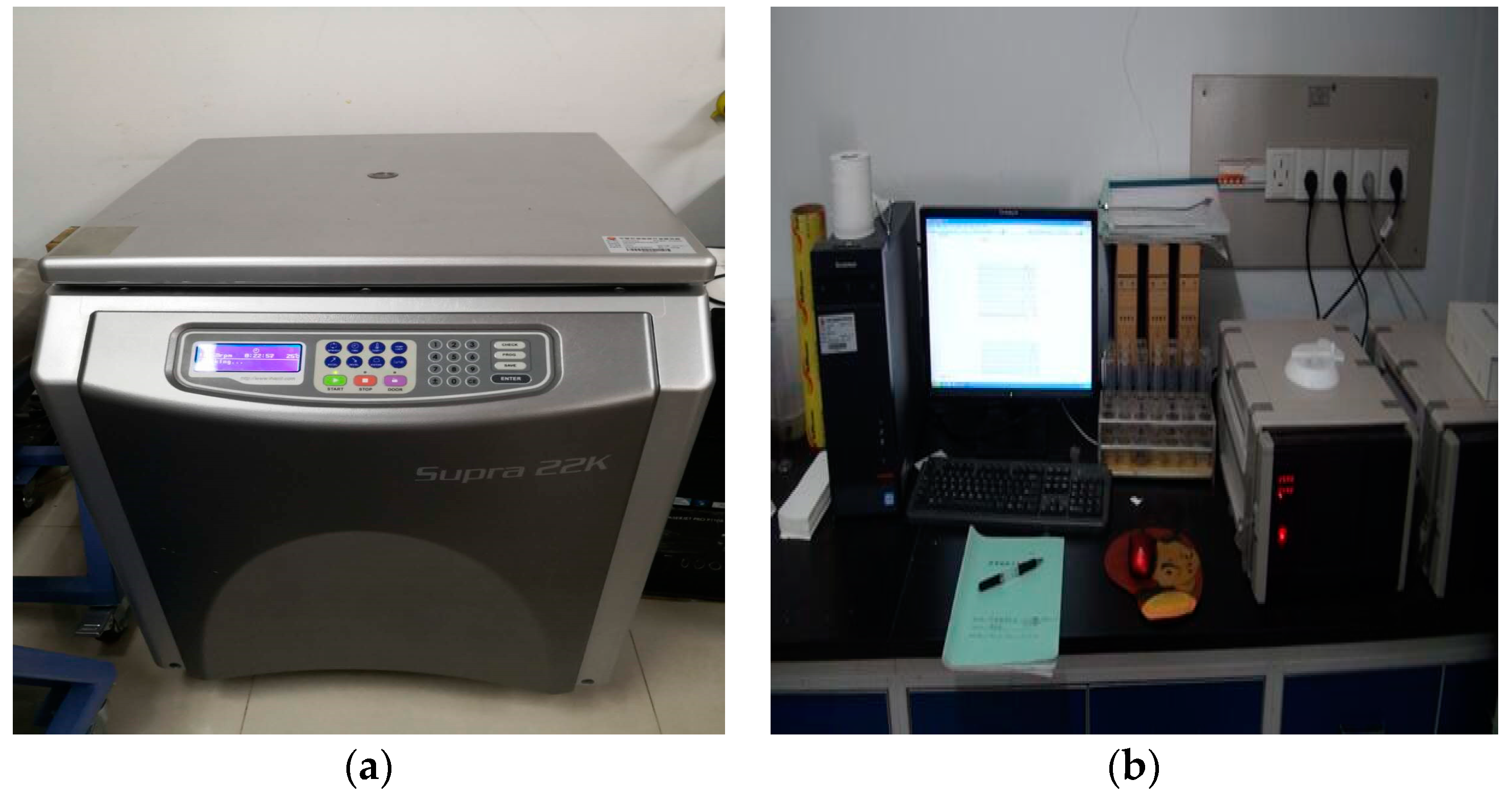


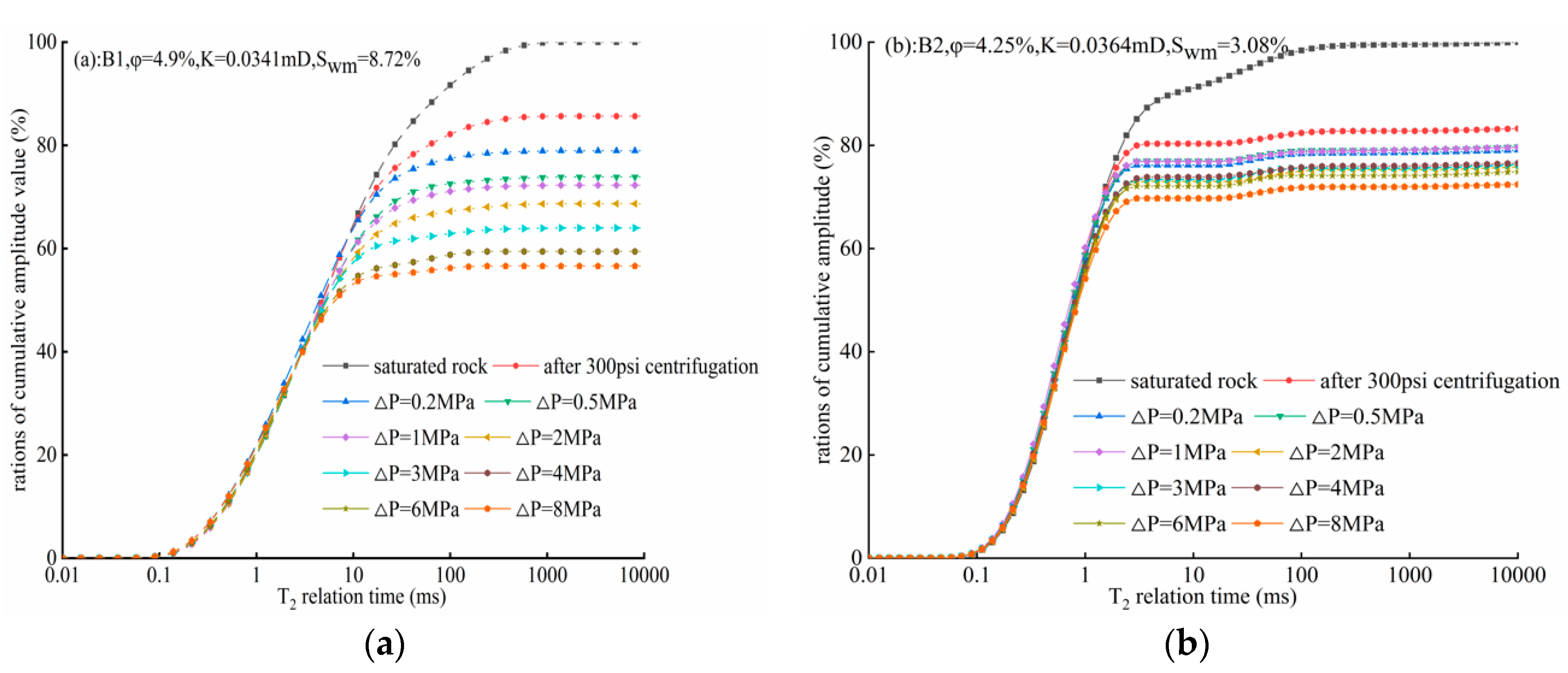
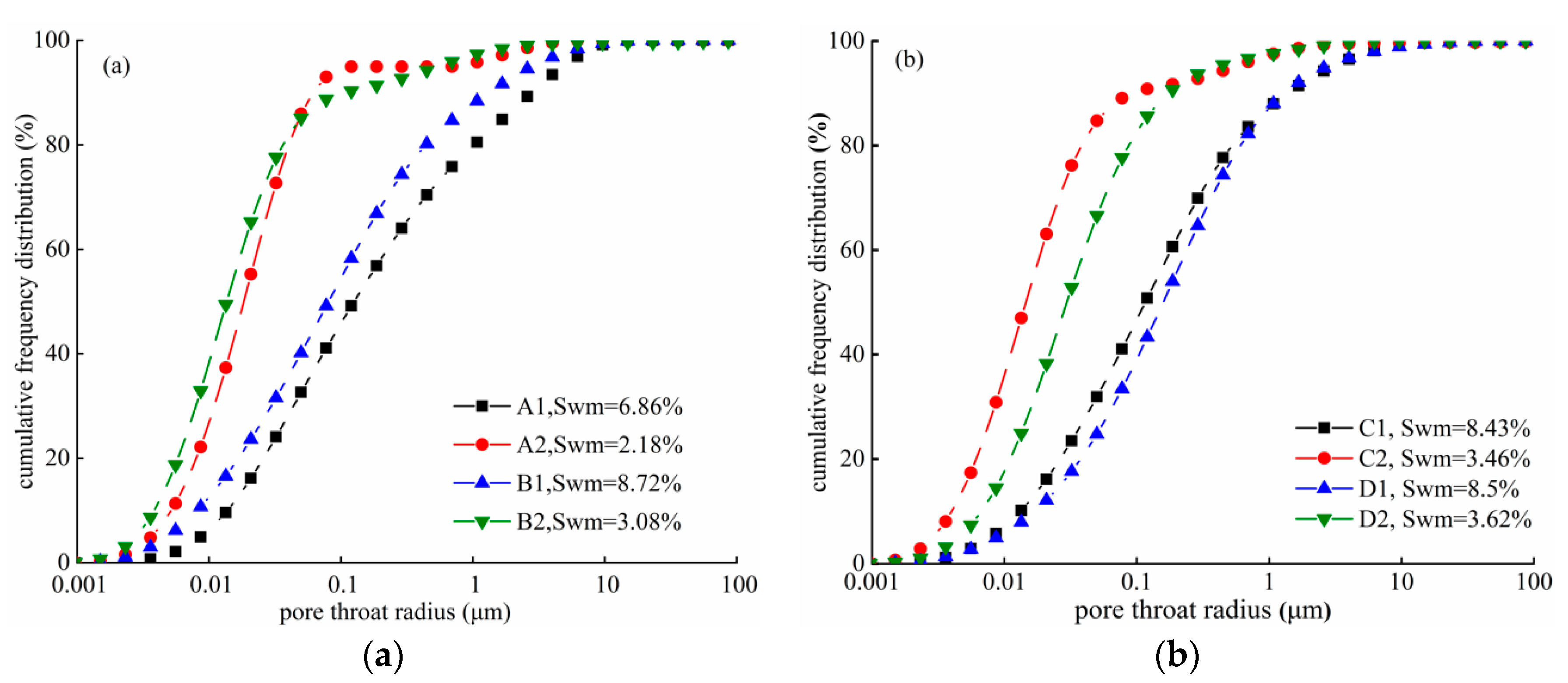
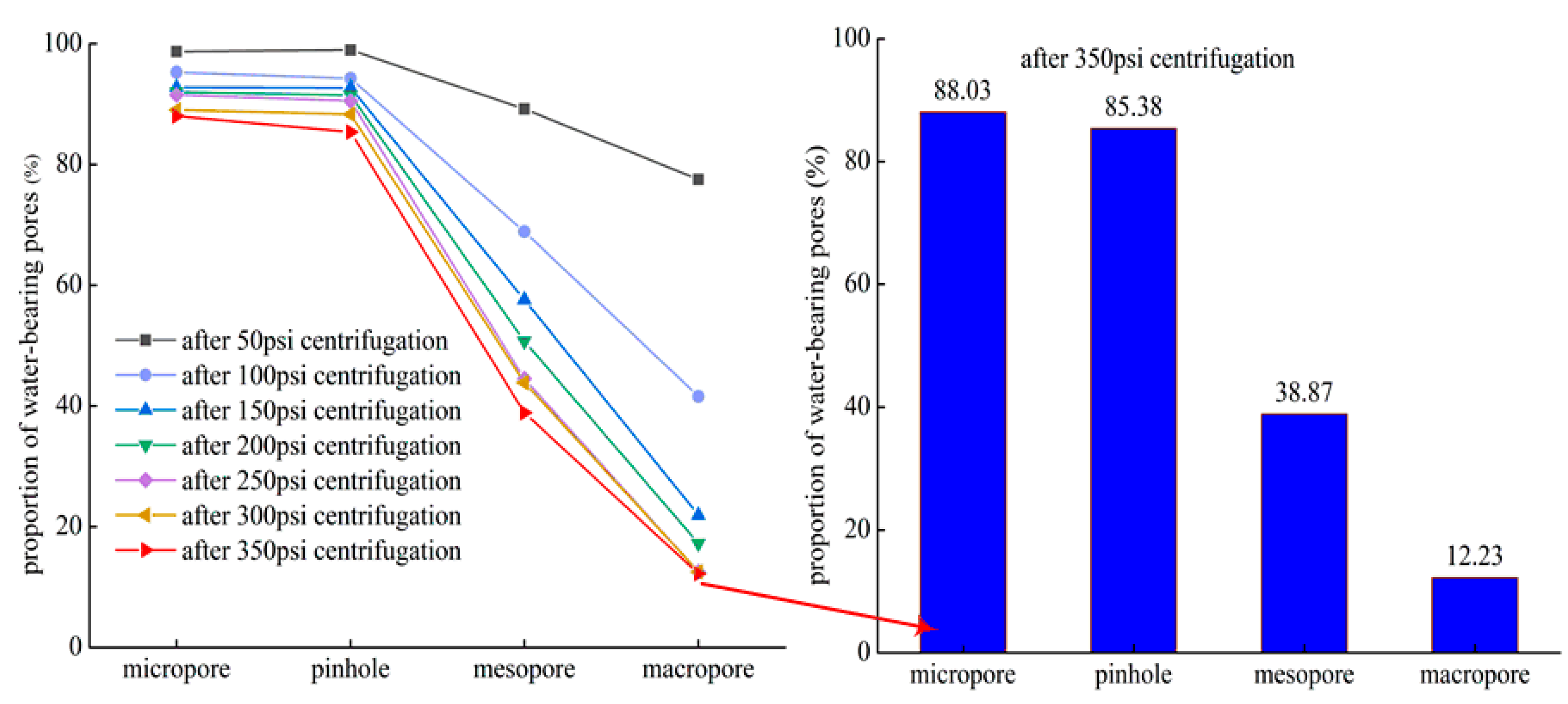
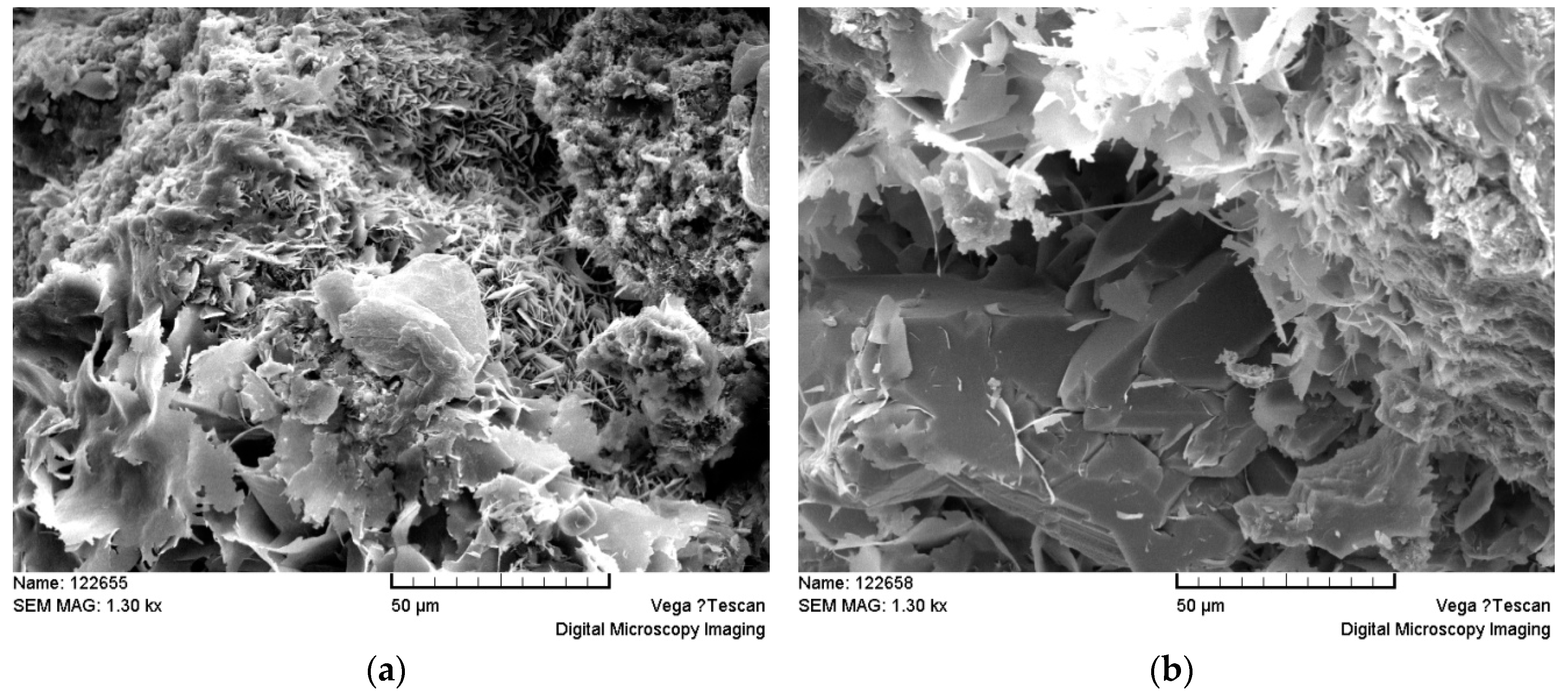
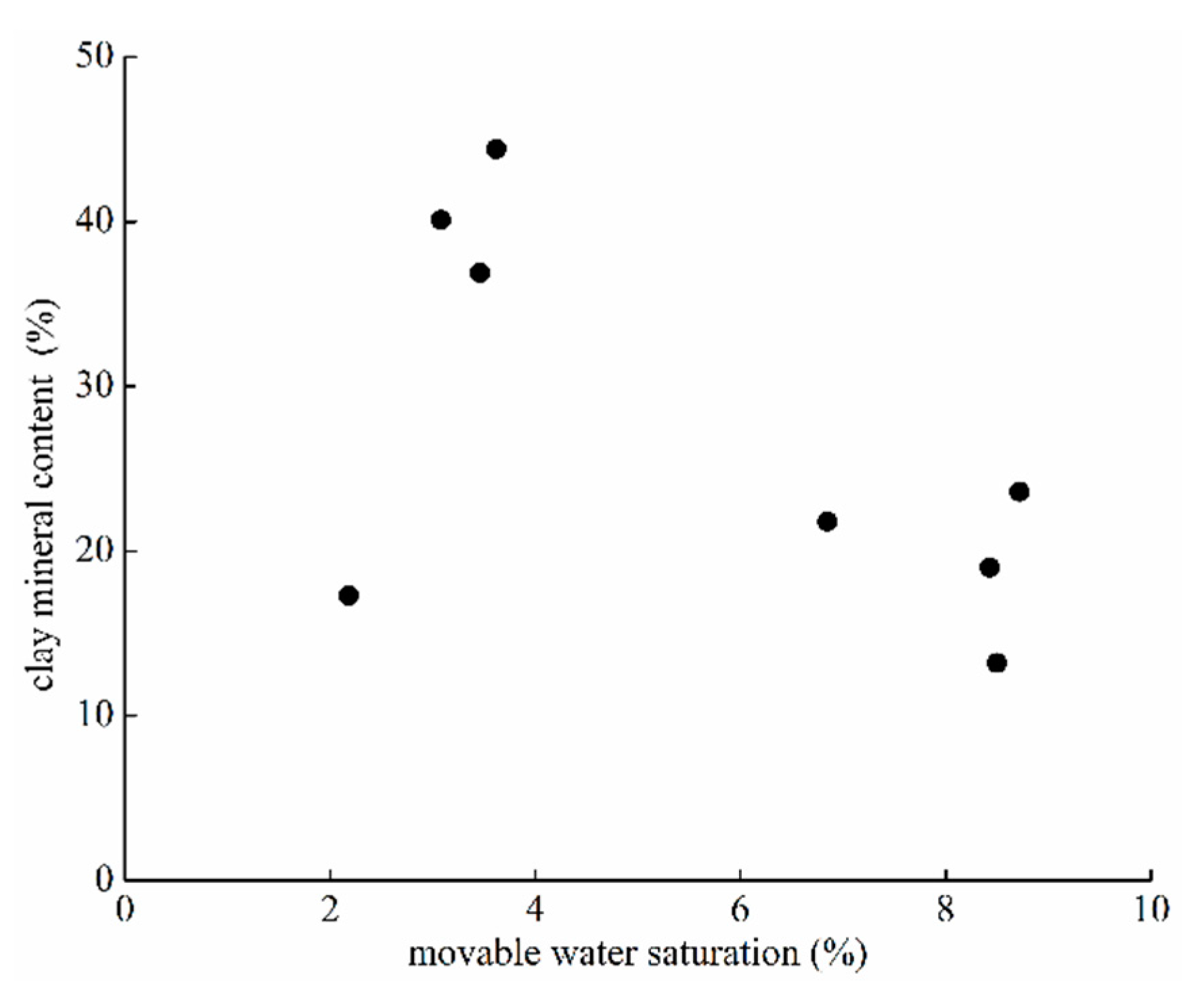


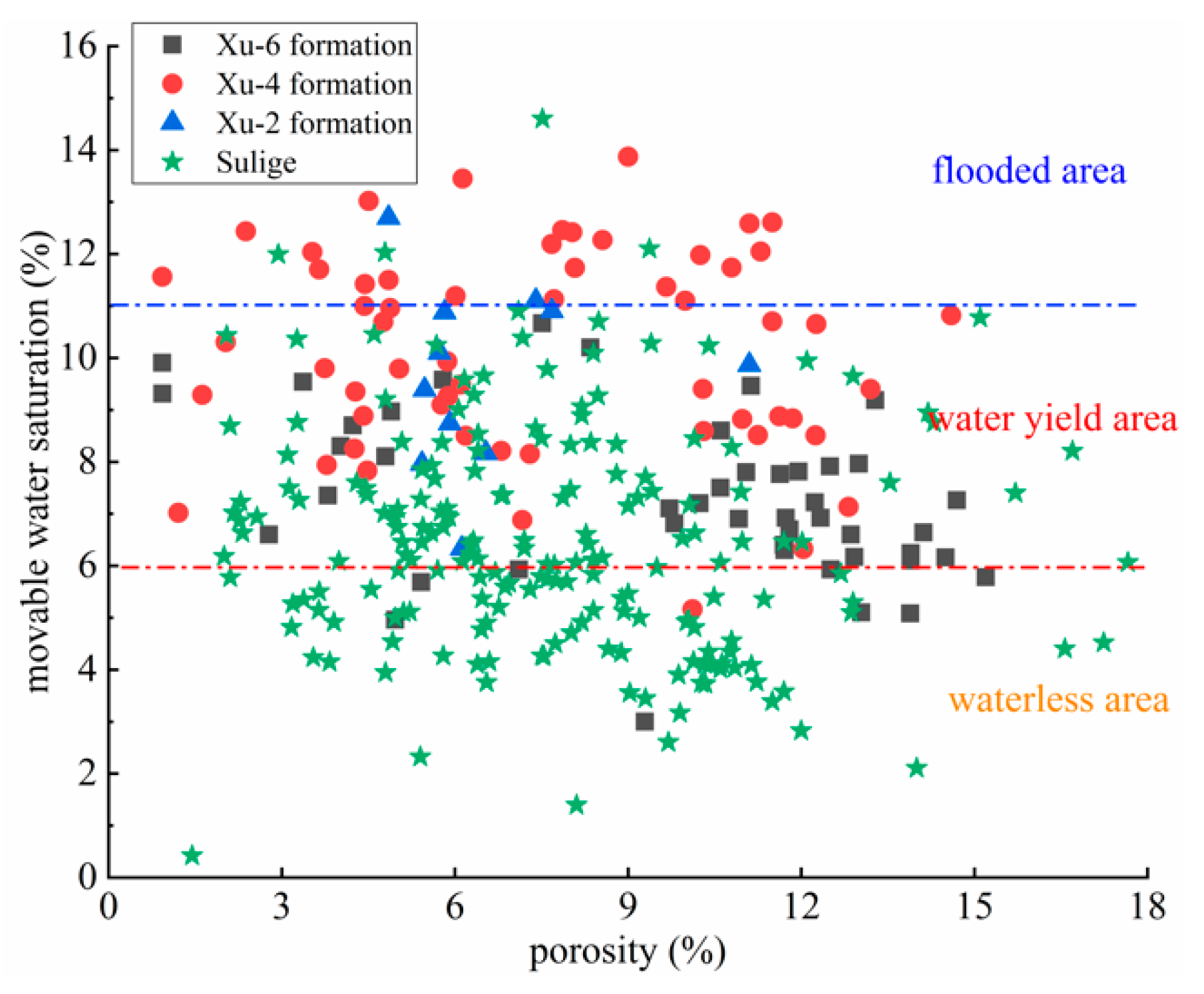

| Group | Core | Permeability (10−3 μm2) | Porosity (%) | Swir (%) | Swm (%) |
|---|---|---|---|---|---|
| 1 | A1 | 0.0206 | 7.63 | 85.12 | 6.85 |
| A2 | 0.0231 | 7.18 | 83.57 | 2.18 | |
| 2 | B1 | 0.0341 | 4.90 | 73.79 | 8.72 |
| B2 | 0.0364 | 4.25 | 73.53 | 3.08 | |
| 3 | C1 | 0.0403 | 7.18 | 85.08 | 8.43 |
| C2 | 0.0476 | 7.02 | 88.17 | 3.46 | |
| 4 | D1 | 0.1132 | 9.50 | 82.80 | 8.50 |
| D2 | 0.117 | 9.34 | 83.27 | 3.62 |
| Pore Throat Type | Pore Throat Radius | Pore Throat Proportion of Different Types (%) | |||||||
|---|---|---|---|---|---|---|---|---|---|
| Group 1 | Group 2 | Group 3 | Group 4 | ||||||
| A1 | A2 | B1 | B2 | C1 | C2 | D1 | D2 | ||
| micropore | <0.01 | 8 | 29 | 13 | 41 | 8 | 39 | 6 | 19 |
| pinhole | 0.01–0.1 | 38 | 66 | 40 | 49 | 44 | 52 | 37 | 66 |
| mesopore | 0.1–1 | 35 | 1 | 35 | 7 | 38 | 6 | 45 | 12 |
| macropore | >1 | 19 | 4 | 12 | 3 | 10 | 3 | 12 | 3 |
© 2020 by the authors. Licensee MDPI, Basel, Switzerland. This article is an open access article distributed under the terms and conditions of the Creative Commons Attribution (CC BY) license (http://creativecommons.org/licenses/by/4.0/).
Share and Cite
Zhang, J.; Li, X.; Shen, W.; Gao, S.; Liu, H.; Ye, L.; Fang, F. Study of the Effect of Movable Water Saturation on Gas Production in Tight Sandstone Gas Reservoirs. Energies 2020, 13, 4645. https://doi.org/10.3390/en13184645
Zhang J, Li X, Shen W, Gao S, Liu H, Ye L, Fang F. Study of the Effect of Movable Water Saturation on Gas Production in Tight Sandstone Gas Reservoirs. Energies. 2020; 13(18):4645. https://doi.org/10.3390/en13184645
Chicago/Turabian StyleZhang, Jie, Xizhe Li, Weijun Shen, Shusheng Gao, Huaxun Liu, Liyou Ye, and Feifei Fang. 2020. "Study of the Effect of Movable Water Saturation on Gas Production in Tight Sandstone Gas Reservoirs" Energies 13, no. 18: 4645. https://doi.org/10.3390/en13184645
APA StyleZhang, J., Li, X., Shen, W., Gao, S., Liu, H., Ye, L., & Fang, F. (2020). Study of the Effect of Movable Water Saturation on Gas Production in Tight Sandstone Gas Reservoirs. Energies, 13(18), 4645. https://doi.org/10.3390/en13184645





